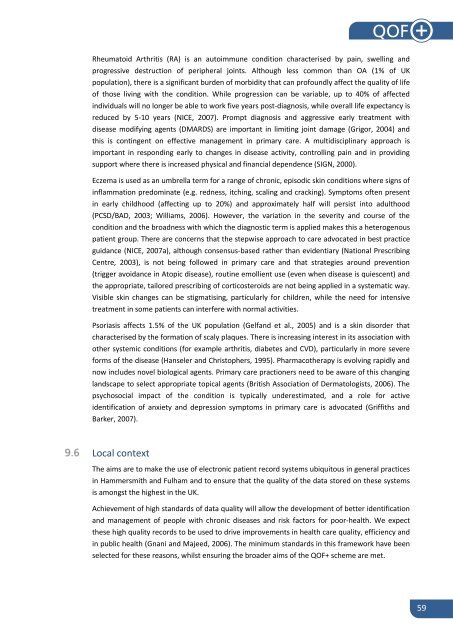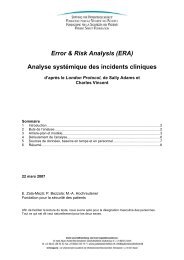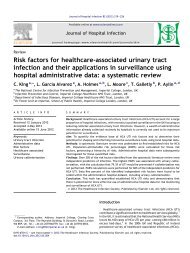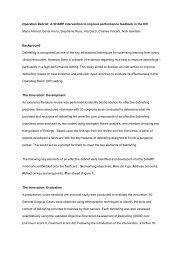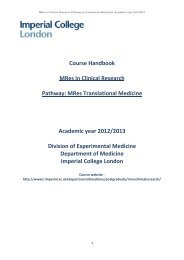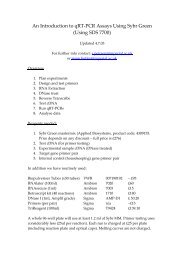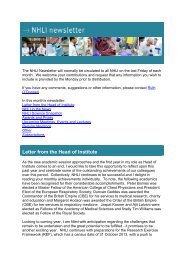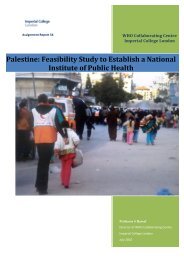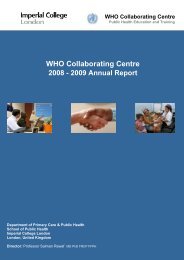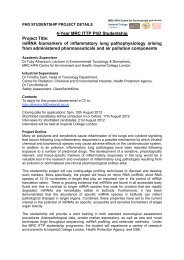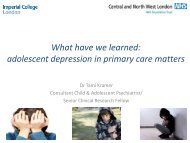QOF Plus Year 1 - Imperial College London
QOF Plus Year 1 - Imperial College London
QOF Plus Year 1 - Imperial College London
Create successful ePaper yourself
Turn your PDF publications into a flip-book with our unique Google optimized e-Paper software.
Rheumatoid Arthritis (RA) is an autoimmune condition characterised by pain, swelling andprogressive destruction of peripheral joints. Although less common than OA (1% of UKpopulation), there is a significant burden of morbidity that can profoundly affect the quality of lifeof those living with the condition. While progression can be variable, up to 40% of affectedindividuals will no longer be able to work five years post-diagnosis, while overall life expectancy isreduced by 5-10 years (NICE, 2007). Prompt diagnosis and aggressive early treatment withdisease modifying agents (DMARDS) are important in limiting joint damage (Grigor, 2004) andthis is contingent on effective management in primary care. A multidisciplinary approach isimportant in responding early to changes in disease activity, controlling pain and in providingsupport where there is increased physical and financial dependence (SIGN, 2000).Eczema is used as an umbrella term for a range of chronic, episodic skin conditions where signs ofinflammation predominate (e.g. redness, itching, scaling and cracking). Symptoms often presentin early childhood (affecting up to 20%) and approximately half will persist into adulthood(PCSD/BAD, 2003; Williams, 2006). However, the variation in the severity and course of thecondition and the broadness with which the diagnostic term is applied makes this a heterogenouspatient group. There are concerns that the stepwise approach to care advocated in best practiceguidance (NICE, 2007a), although consensus-based rather than evidentiary (National PrescribingCentre, 2003), is not being followed in primary care and that strategies around prevention(trigger avoidance in Atopic disease), routine emollient use (even when disease is quiescent) andthe appropriate, tailored prescribing of corticosteroids are not being applied in a systematic way.Visible skin changes can be stigmatising, particularly for children, while the need for intensivetreatment in some patients can interfere with normal activities.Psoriasis affects 1.5% of the UK population (Gelfand et al., 2005) and is a skin disorder thatcharacterised by the formation of scaly plaques. There is increasing interest in its association withother systemic conditions (for example arthritis, diabetes and CVD), particularly in more severeforms of the disease (Hanseler and Christophers, 1995). Pharmacotherapy is evolving rapidly andnow includes novel biological agents. Primary care practioners need to be aware of this changinglandscape to select appropriate topical agents (British Association of Dermatologists, 2006). Thepsychosocial impact of the condition is typically underestimated, and a role for activeidentification of anxiety and depression symptoms in primary care is advocated (Griffiths andBarker, 2007).Local contextThe aims are to make the use of electronic patient record systems ubiquitous in general practicesin Hammersmith and Fulham and to ensure that the quality of the data stored on these systemsis amongst the highest in the UK.Achievement of high standards of data quality will allow the development of better identificationand management of people with chronic diseases and risk factors for poor-health. We expectthese high quality records to be used to drive improvements in health care quality, efficiency andin public health (Gnani and Majeed, 2006). The minimum standards in this framework have beenselected for these reasons, whilst ensuring the broader aims of the <strong>QOF</strong>+ scheme are met.59


